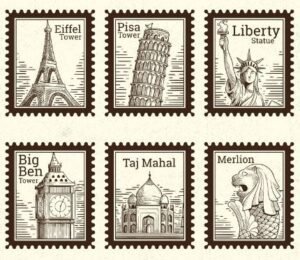Stamp collecting is more than just a hobby—it’s a window into history, art, and culture. As a passionate collector, it’s essential to understand stamp heritage and culture to fully appreciate the rich significance of each stamp. Stamps offer a unique glimpse into the world’s diverse cultures, histories, and traditions, and understanding their heritage adds depth to the collecting experience. However, along with the excitement of discovering rare and beautiful stamps, collectors must also be cautious of common mistakes that can affect the value and significance of their collection.
In this article, we’ll explore how understanding stamp heritage and culture can enrich your collecting journey and guide you in making informed decisions. We’ll also highlight some common pitfalls that collectors face, and how you can avoid them to ensure you build a valuable, meaningful collection.

1. The Historical Significance of Stamps: A Reflection of Culture
Stamps are often referred to as “miniature works of art,” and for good reason. They reflect the culture, values, and history of the country or entity that issued them. Whether it’s a stamp commemorating an important historical event, a cultural icon, or a natural wonder, understanding stamp heritage and culture allows collectors to appreciate these small artifacts beyond their face value.
For example, early stamps from countries like Great Britain or the United States offer insight into the evolution of communication and postal services. Later stamps may reflect major global events, such as wars, political movements, or the rise of technology. Collectors can also discover the artistry involved in stamp design—many stamps feature intricate illustrations or symbols that hold deep cultural meaning.
Understanding the heritage and culture of these stamps enables collectors to see them as more than just collectibles. They become time capsules, offering a snapshot of a particular moment in history, the values of a society, and the artistry that went into their design.
2. The Beauty of Cultural Diversity in Stamp Collecting
One of the most rewarding aspects of stamp collecting is exploring the wide variety of cultures represented in stamp issues. Stamps from different countries and regions reflect their unique cultural practices, traditions, and artistic expressions. Understanding stamp heritage and culture allows collectors to gain a deeper appreciation for the global diversity of stamp designs, colors, and themes.
For example, stamps from Japan often feature traditional symbols, such as cherry blossoms or Mount Fuji, while stamps from African countries might showcase vibrant colors and imagery related to wildlife or indigenous cultures. European stamps frequently commemorate historic figures, architecture, and royal family members.
By collecting stamps from various parts of the world, collectors can experience the beauty of diverse cultures while building a collection that tells a global story. Each stamp, with its unique design and background, offers a reflection of the people, history, and values of the country from which it originated.
3. Common Collecting Mistakes and How to Avoid Them
While understanding stamp heritage and culture can significantly enhance your collecting experience, it’s equally important to be aware of common mistakes that can harm your collection’s value and integrity. Many collectors, especially beginners, may inadvertently make errors that can impact the quality and worth of their collection. Here are some of the most frequent pitfalls and how to avoid them:

- Misidentifying Stamps: One of the biggest mistakes collectors make is misidentifying a stamp. Stamps from different periods or countries can look remarkably similar, especially to the untrained eye. Without understanding stamp heritage and culture, it’s easy to confuse stamps or incorrectly assume their value. To avoid this, always refer to trusted stamp catalogs or consult with experienced collectors when you’re uncertain about the identity of a stamp.
- Overlooking Condition and Quality: The condition of a stamp is one of the most important factors in determining its value. Stamps with creases, tears, or discoloration are significantly less valuable than those in pristine condition. Understanding stamp heritage and culture involves recognizing the importance of preservation and how small imperfections can drastically reduce a stamp’s worth. Be mindful of how you store and handle your collection to avoid causing irreversible damage.
- Overpaying for Common Stamps: Many new collectors fall into the trap of overpaying for stamps that appear rare but are actually quite common. This happens when collectors fail to properly research a stamp’s rarity and market value. By understanding stamp heritage and culture, you can better assess the true rarity of a stamp and avoid spending more than it’s worth. Always consult a price guide or auction results to get a clear picture of the stamp’s market value.
- Not Keeping Proper Records: Another mistake collectors often make is failing to maintain accurate records of their collection. Noting the purchase price, provenance, and any historical details related to each stamp is crucial for ensuring the integrity and value of your collection over time. Understanding stamp heritage and culture also means recognizing the historical and cultural significance of each piece and keeping detailed records to preserve its legacy.
- Neglecting Stamp Authentication: In the world of philately, there are unfortunately counterfeit and forgeries to be aware of. Some stamps that appear to be rare or valuable may not be authentic. Understanding stamp heritage and culture can help you spot obvious signs of a forgery, but when in doubt, always seek professional authentication before purchasing high-value stamps. Many respected auction houses and dealers offer authentication services.

4. Building a Valuable Collection: Focus on Knowledge and Passion
While avoiding mistakes is essential, the most rewarding aspect of stamp collecting is building a collection that reflects your own passions and interests. Understanding stamp heritage and culture not only helps you avoid common errors, but it also inspires you to pursue the stamps that truly excite you.
Whether you’re drawn to stamps from a particular country, historical era, or theme (such as wildlife, architecture, or famous personalities), focus on what makes your collection meaningful to you. Passion for the subject matter will lead you to learn more about each stamp’s significance, enhancing your enjoyment and appreciation of your collection.
Additionally, a well-curated collection based on understanding stamp heritage and culture is often more valuable than a random assortment of stamps. Collectors who specialize in a certain area—such as stamps related to a particular historical event or cultural theme—often find that their collections become both more valuable and more enjoyable over time.
5. The Future of Stamp Collecting: Embracing New Trends and Technologies
As stamp collecting continues to evolve, new technologies and trends are changing the way collectors acquire and engage with stamps. Understanding stamp heritage and culture not only involves appreciating traditional collecting methods but also staying informed about digital tools, online auctions, and other innovations in the hobby.
For instance, digital catalogs, online auctions, and even blockchain technology are now being used to authenticate and trade stamps. By keeping up with these trends, collectors can continue to enjoy the beauty of stamps while embracing the new opportunities and challenges that modern technology offers.

Conclusion
Understanding stamp heritage and culture is essential for every collector. It adds depth and meaning to your collection, allowing you to appreciate the beauty, history, and cultural significance of each stamp. By avoiding common collecting mistakes and focusing on knowledge, passion, and preservation, you can build a collection that is both personally fulfilling and financially valuable. Whether you’re a beginner or an experienced philatelist, the beauty of stamp collecting lies in its endless opportunities for learning, discovery, and connection to the world’s diverse cultures and histories.



